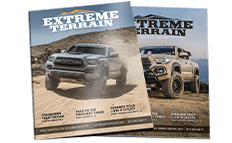2018 Toyota Tundra
The 2018 Toyota Tundra receives a TRD Sport Package for the SR5 trim. It includes bespoke 20-inch wheels, sport suspension, LED headlights, LED fog lights, a hood scoop, and model-specific body graphics. The second-gen Tundra is available in two V8 engine options. Standard is a 4.6-liter V8 with 310 horsepower and 327 pound-feet of torque, while the larger 5.7-liter V8 has 381 horsepower and 401 pound-feet of torque. Gone for 2018 is the Standard Cab body style. However, it remains available in a Double Cab or CrewMax body style with a 5.5-foot, 6.5-foot, or 8.1-foot bed.
Changing Gears
The 2018 Toyota Tundra’s rear differential has a 10.5-inch ring gear and an aggressive 4.30 rear axle ratio. Changing the gear ratio and the differential gears in your Toyota truck is all about selecting the best compromise. When upgrading to bigger wheels and tires, upgrading from the stock ring and pinion gears will restore lost performance while taking advantage of better torque. Remember that a numerically lower (or taller) gear ratio is ideal for increasing the top speed, while a higher (or shorter) gear ratio offers zippier acceleration. This is all accomplished through manipulating torque between the input and output of the differential. With a 4.30 gear, it means the drive shaft has to spin 4.30 to make one revolution of the wheels. Increasing this ratio would increase the RPM of the engine to turn the wheel at the same given speed, meaning you run out of gear and hit the rev limit at a lower speed. The opposite is true of a numerically lower gear - the engine will be at a lower RPM for any given vehicle speed. That said, a lower gear will help a 2018 Tundra with towing and hauling, at the expense of some extra fuel.
Raise or Lower
You have two choices when it comes to upgrading the style of your Toyota Tundra. You can raise the suspension with a lift kit, or you can lower it to bring out the street credentials of your rig. Choosing the lift kit height depends on the size of your wheel and tire combo. For most stock applications with 33-inch tires, a one or two-inch lift kit or leveling kit is ideal. But for bigger 35 to 37-inch tires, a three-inch to six-inch lift kit may be required. But if your truck is a street dweller, a complete lowering kit with front coil springs, performance shock absorbers, and a rear flip kit will improve handling and responsiveness while giving your rig a sportier stance. Most lowering kits will drop the front of your Tundra by two inches and around four inches in the rear. It’s not low enough to scrape the ground but low enough to tell others your truck means business.
Shock Therapy
When upgrading to a one or two-inch lift kit, you can use the factory shocks, but you need a new set of shock absorbers when raising the truck by three inches or higher. And while most people will associate shock absorbers with ride comfort, the dampers are responsible for maintaining proper tire contact and controlling the oscillations of the coil springs and leaf springs. Off-road shock absorbers for lifted trucks are different than stock. Usually monotube design, off-road and lift intended shock absorbers use a nitrogen charge on the opposite side of the oil reservoir and piston assembly to keep actuation smooth. The interior valves are specifically tuned to handle the increased range of motion and prevent cavitation and frothing within the oil. All this to say, aftermarket shock absorbers are built bigger and stronger, with better fluid dynamics suited to an off-road and lifted Tundra.

















